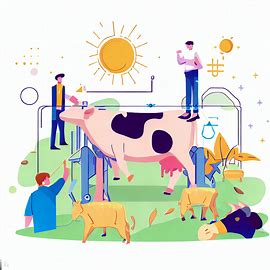
Introduction
Animal husbandry is a critical component of agriculture, contributing significantly to our food supply and playing a substantial role in the economy.
This practice involves managing and caring for farm animals by humans where the properties of these animals are utilized to produce commodities such as food, fiber, and labor.
History of Animal Husbandry
The practice of animal husbandry dates back thousands of years, evolving alongside human civilization.
Initially, humans raised animals primarily for labor and transportation. However, the practice expanded to include the production of commodities like milk, meat, and eggs - essentially giving rise to modern dairy farming and poultry farming.
The understanding of animal behavior and health played a crucial role in this evolution.
Types of Animals in Husbandry
Animal husbandry encompasses a variety of animals, the most common of which are cattle, sheep, pigs, and chickens.
Each species requires specific management practices concerning nutrition, breeding, and handling.
For example, grazing is a common practice for managing cattle and sheep, while pigs and chickens are usually raised in more confined livestock housing.
Basic Practices in Animal Husbandry
Key practices in animal husbandry include breeding, feeding, disease management, and waste management.
Feeding, a fundamental aspect, involves providing livestock feed formulated to meet the specific dietary needs of each animal.
This practice contributes to both animal welfare and productivity.
Breeding practices in animal husbandry often employ knowledge of animal genetics to improve stock and manage genetic disorders.
For example, selective breeding allows farmers to enhance desirable traits, such as high milk production in dairy cows or rapid growth in broiler chickens.
Disease management is another essential component. Regular vaccinations, parasite control, and biosecurity measures help prevent the spread of livestock diseases.
Monitoring animal health and behavior is also crucial for early disease detection.
Finally, waste management is vital in maintaining a clean, healthy environment for the animals and the people caring for them.
Animal Nutrition and Health
Proper animal nutrition is a cornerstone of successful animal husbandry. The balance of carbohydrates, proteins, vitamins, and minerals in livestock feed directly impacts animals' health and productivity.
Overseeing animal health also involves regular health check-ups and prompt treatment of illnesses.
Ethical and Sustainable Practices
Sustainable farming practices are increasingly important in modern animal husbandry.
These include rotational grazing, organic farming, and using feed and breed selections that promote animal welfare and environmental sustainability.
Additionally, the ethical treatment of animals is paramount and intertwined with good farming practices. Ensuring proper living conditions, humane handling, and avoiding unnecessary stress are all aspects of ethical animal husbandry.
Challenges and Solutions in Animal Husbandry
Animal husbandry faces numerous challenges. Disease outbreaks, effects of climate change, balancing productivity with animal welfare, and market fluctuations are a few examples.
Solutions may involve using more resilient breeds, adopting sustainable farming practices, utilizing technology for early disease detection, and supporting farmers with fair livestock market practices.
Career and Education in Animal Husbandry
A career in animal husbandry requires knowledge of animal science, farm management, and a dedication to animal care.
Many institutions offer courses and degrees in related fields. The livestock industry offers diverse opportunities, from being a hands-on farm manager to conducting research or working in animal health.
Modern Technologies and Trends in Animal Husbandry
Modern animal husbandry has started to embrace technology, leading to a shift towards precision farming.
Automated feeding systems, digital health monitoring of livestock, and genetic engineering are a few examples of technology in use. These technologies can improve productivity, animal welfare, and sustainability.
Conclusion
Animal husbandry is a complex field that combines knowledge of animal science, management, and technology.
Its importance extends beyond the livestock industry, impacting our food supply, economy, and environment.
As the field continues to evolve, so too do our practices and understandings of how to best manage and care for these vital animals.
From embracing sustainable farming practices and organic farming to applying modern technologies for health monitoring and precision farming, the industry is continually evolving.
Ethical considerations are now at the forefront, with a greater focus on animal welfare, humane treatment, and minimizing environmental impact.
At its heart, animal husbandry is about the responsible care and management of animals.
And in this crucial role, farmers, livestock handlers, and everyone involved in the animal husbandry sector have a significant responsibility.
Not just in providing the necessities of food and fiber, but also in safeguarding the welfare of the animals in their care and the sustainability of our environment.
Whether you're looking to start a career in animal husbandry, seeking to improve your existing farm management practices, or are simply interested in understanding where and how our animal products come from, the study and practice of animal husbandry offers a diverse and fulfilling path.
In essence, the basics of animal husbandry boil down to knowledge, care, and a commitment to continual learning and adaptation. With these, the potential to contribute positively to this essential field is vast.
